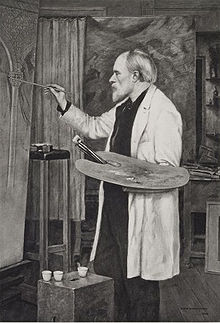Our website is made possible by displaying online advertisements to our visitors.
Please consider supporting us by disabling your ad blocker.
Edward Burne-Jones
Edward Burne-Jones | |
|---|---|
 Photogravure of a portrait of Edward Burne-Jones by his son Philip Burne-Jones, 1898 | |
| Born | Edward Coley Burne Jones 28 August 1833 Birmingham, England |
| Died | 17 June 1898 (aged 64) London, England |
| Known for | Painting |
| Movement | |
| Spouse | |
| Partner | Maria Zambaco (1866–1869) |
| Relatives |
|
Sir Edward Coley Burne-Jones, 1st Baronet, ARA (/bɜːrnˈdʒoʊnz/;[1] 28 August 1833 – 17 June 1898) was an English painter and designer associated with the Pre-Raphaelite Brotherhood's style and subject matter.[2]
Burne-Jones worked with William Morris as a founding partner in Morris, Marshall, Faulkner & Co in the design of decorative arts.[3] His early paintings show the influence of Dante Gabriel Rossetti, but by 1870 he had developed his own style. In 1877, he exhibited eight oil paintings at the Grosvenor Gallery, a new rival to the Royal Academy of Arts. These included The Beguiling of Merlin. The timing was right and he was taken up as a herald and star of the new Aesthetic Movement.
In the studio of Morris and Co. Burne-Jones worked as a designer of a wide range of crafts including ceramic tiles, jewellery, tapestries, and mosaics. Among his most significant and lasting designs are those for stained glass windows the production of which was a revived craft during the 19th century. His designs are still to be found in churches across the UK, with examples in the US and Australia.
- ^ "Burne-Jones". Collins English Dictionary.
- ^ Lehnebach, Carlos A.; Regnault, Claire; Rice, Rebecca; Awa, Isaac Te; Yates, Rachel A. (1 November 2023). Flora: Celebrating our Botanical World. Te Papa Press. pp. 94–95. ISBN 978-1-9911509-1-2.
- ^ Cite error: The named reference
milwas invoked but never defined (see the help page).
Previous Page Next Page


